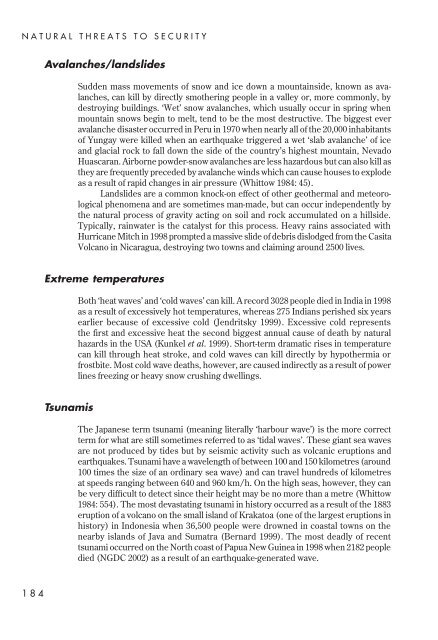Understanding global security - Peter Hough
Understanding global security - Peter Hough
Understanding global security - Peter Hough
Create successful ePaper yourself
Turn your PDF publications into a flip-book with our unique Google optimized e-Paper software.
NATURAL THREATS TO SECURITY<br />
Avalanches/landslides<br />
Sudden mass movements of snow and ice down a mountainside, known as avalanches,<br />
can kill by directly smothering people in a valley or, more commonly, by<br />
destroying buildings. ‘Wet’ snow avalanches, which usually occur in spring when<br />
mountain snows begin to melt, tend to be the most destructive. The biggest ever<br />
avalanche disaster occurred in Peru in 1970 when nearly all of the 20,000 inhabitants<br />
of Yungay were killed when an earthquake triggered a wet ‘slab avalanche’ of ice<br />
and glacial rock to fall down the side of the country’s highest mountain, Nevado<br />
Huascaran. Airborne powder-snow avalanches are less hazardous but can also kill as<br />
they are frequently preceded by avalanche winds which can cause houses to explode<br />
as a result of rapid changes in air pressure (Whittow 1984: 45).<br />
Landslides are a common knock-on effect of other geothermal and meteorological<br />
phenomena and are sometimes man-made, but can occur independently by<br />
the natural process of gravity acting on soil and rock accumulated on a hillside.<br />
Typically, rainwater is the catalyst for this process. Heavy rains associated with<br />
Hurricane Mitch in 1998 prompted a massive slide of debris dislodged from the Casita<br />
Volcano in Nicaragua, destroying two towns and claiming around 2500 lives.<br />
Extreme temperatures<br />
Both ‘heat waves’ and ‘cold waves’ can kill. A record 3028 people died in India in 1998<br />
as a result of excessively hot temperatures, whereas 275 Indians perished six years<br />
earlier because of excessive cold (Jendritsky 1999). Excessive cold represents<br />
the first and excessive heat the second biggest annual cause of death by natural<br />
hazards in the USA (Kunkel et al. 1999). Short-term dramatic rises in temperature<br />
can kill through heat stroke, and cold waves can kill directly by hypothermia or<br />
frostbite. Most cold wave deaths, however, are caused indirectly as a result of power<br />
lines freezing or heavy snow crushing dwellings.<br />
Tsunamis<br />
The Japanese term tsunami (meaning literally ‘harbour wave’) is the more correct<br />
term for what are still sometimes referred to as ‘tidal waves’. These giant sea waves<br />
are not produced by tides but by seismic activity such as volcanic eruptions and<br />
earthquakes. Tsunami have a wavelength of between 100 and 150 kilometres (around<br />
100 times the size of an ordinary sea wave) and can travel hundreds of kilometres<br />
at speeds ranging between 640 and 960 km/h. On the high seas, however, they can<br />
be very difficult to detect since their height may be no more than a metre (Whittow<br />
1984: 554). The most devastating tsunami in history occurred as a result of the 1883<br />
eruption of a volcano on the small island of Krakatoa (one of the largest eruptions in<br />
history) in Indonesia when 36,500 people were drowned in coastal towns on the<br />
nearby islands of Java and Sumatra (Bernard 1999). The most deadly of recent<br />
tsunami occurred on the North coast of Papua New Guinea in 1998 when 2182 people<br />
died (NGDC 2002) as a result of an earthquake-generated wave.<br />
184
















